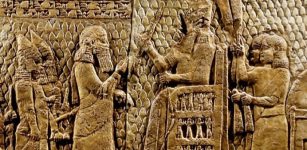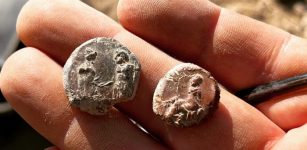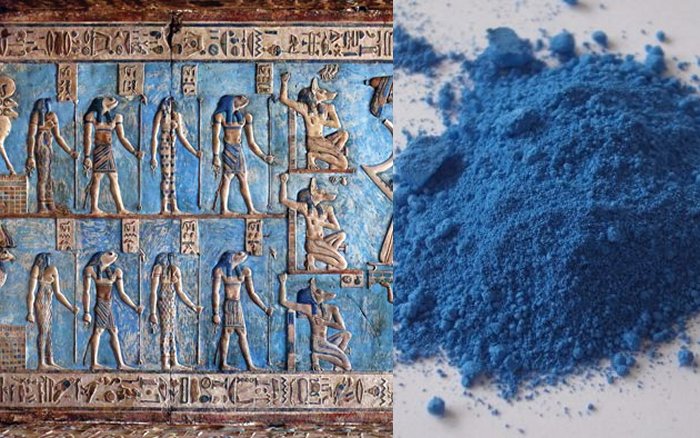Egyptian Blue: World’s Oldest Artificial Pigment
AncientPages.com - Question: What was the Egyptian blue?
Answer: The Egyptian blue is the world’s oldest artificial pigment. It appeared about 5,000 years ago in a tomb painting dated to the reign of Ka-sen, the last king of Egypt's First Dynasty.
Scientists have discovered that the Egyptian blue pigment has extraordinary properties and will enable us not only to reconstruct the past, but also possibly to shape the technological future.
The material giving Egyptian blue its color is calcium copper silicate. It was made by grinding sand, lime and copper (or copper ore) and heating the mixture in a furnace.
See also: Ancient Egyptians Had The First Governmental Health Care System
Egyptian blue was widely used in ancient times as a pigment in painting, such as in wall paintings, tombs, mummies’ coffins and a ceramic glaze known as Egyptian faience. The fact that it was not available naturally meant that its presence indicated a work that had considerable prestige. Its use spread throughout Egypt, Mesopotamia, Greece, and the far reaches of the Roman Empire. It was often used as a substitute for lapis lazuli, an extremely expensive and rare mineral sourced in Afghanistan.
Scientists have noticed that when irradiated with visible light, Egyptian blue emits near-infrared rays with exceptional strength, with even single particles of the pigment detectable from a distance of a few yards.
This suggests Egyptian blue could have a variety of modern applications. For example, it could soon be used in advanced biomedical engineering. Expanding on the ancient Egyptian concept with the pigment's near-infrared-emitting property, scientists can also use it as a nano-ink.
So, the Egyptian blue is certainly more than just a color.
AncientPages.com
Expand for referencesSource:
More From Ancient Pages
-
 Christmas – One Of Most Celebrated Holidays In Christian Calendar
Ancient Traditions And Customs | Dec 24, 2018
Christmas – One Of Most Celebrated Holidays In Christian Calendar
Ancient Traditions And Customs | Dec 24, 2018 -
 Medieval Celtic Mystery Written In Konungs Skuggsja – The King’s Mirror
Featured Stories | Sep 13, 2018
Medieval Celtic Mystery Written In Konungs Skuggsja – The King’s Mirror
Featured Stories | Sep 13, 2018 -
 Moses’ Secret Knowledge Of Superior And Forbidden Technology – Alien Intervention And Events Erased From Historical Records – Part 2
Biblical Mysteries | Sep 24, 2020
Moses’ Secret Knowledge Of Superior And Forbidden Technology – Alien Intervention And Events Erased From Historical Records – Part 2
Biblical Mysteries | Sep 24, 2020 -
 DNA From 10,000-Year-Old Scandinavian Chewing Gum Reveals Stone Age Diet
DNA | Jan 19, 2024
DNA From 10,000-Year-Old Scandinavian Chewing Gum Reveals Stone Age Diet
DNA | Jan 19, 2024 -
 Beautiful Ancient City Of Pisac In The Sacred Valley, Peru – Incredible Inca Ruins
Featured Stories | Jun 22, 2017
Beautiful Ancient City Of Pisac In The Sacred Valley, Peru – Incredible Inca Ruins
Featured Stories | Jun 22, 2017 -
 Mysterious Ancient Danube Stone Faces And The Fish Goddess Connection
Artifacts | Dec 18, 2019
Mysterious Ancient Danube Stone Faces And The Fish Goddess Connection
Artifacts | Dec 18, 2019 -
 Lost Kingdom Of Idu And Its Seven Unknown Kings
Civilizations | Jul 25, 2023
Lost Kingdom Of Idu And Its Seven Unknown Kings
Civilizations | Jul 25, 2023 -
 On This Day In History: Riot Over Wine In Oxford – On Feb 10, 1355
News | Feb 10, 2017
On This Day In History: Riot Over Wine In Oxford – On Feb 10, 1355
News | Feb 10, 2017 -
 Australia’s Two-Meter-Long And Oldest Known Rock Painting Of A Kangaroo – Revealed
News | Feb 23, 2021
Australia’s Two-Meter-Long And Oldest Known Rock Painting Of A Kangaroo – Revealed
News | Feb 23, 2021 -
 Ruins Of Xunantunich – Mayan City That Once Flourished
Civilizations | Jan 12, 2022
Ruins Of Xunantunich – Mayan City That Once Flourished
Civilizations | Jan 12, 2022 -
 More Than 2,000 Seal Impressions Found In The Ancient City Of Doliche
Archaeology | Nov 24, 2023
More Than 2,000 Seal Impressions Found In The Ancient City Of Doliche
Archaeology | Nov 24, 2023 -
 The 5,500-Year-Old Underground Rock Settlement With Illuminated Galleries In Ancient City Of Hadrianopolis, Turkey
Archaeology | Sep 18, 2023
The 5,500-Year-Old Underground Rock Settlement With Illuminated Galleries In Ancient City Of Hadrianopolis, Turkey
Archaeology | Sep 18, 2023 -
 Artifacts From King Henry VIII’s Warship The Mary Rose – Analyzed
Archaeology | Apr 28, 2020
Artifacts From King Henry VIII’s Warship The Mary Rose – Analyzed
Archaeology | Apr 28, 2020 -
 Tír na nÓg – Mythical Land Where Time Floats Slower Than In Mortal Lands
Celtic Mythology | Mar 2, 2020
Tír na nÓg – Mythical Land Where Time Floats Slower Than In Mortal Lands
Celtic Mythology | Mar 2, 2020 -
 Mysterious Ancient African Sky Fathers
African Mythology | Jun 18, 2019
Mysterious Ancient African Sky Fathers
African Mythology | Jun 18, 2019 -
 Rose Cross – Powerful Symbol That Existed Long Before Christianity
Ancient Symbols | Dec 3, 2017
Rose Cross – Powerful Symbol That Existed Long Before Christianity
Ancient Symbols | Dec 3, 2017 -
 Satellites Discover Over 160 Hidden Ancient Mounds In North America
Archaeology | Aug 2, 2018
Satellites Discover Over 160 Hidden Ancient Mounds In North America
Archaeology | Aug 2, 2018 -
 Potlatch: Ancient North American Indian Tradition Of Very Generous Gift Giving
Ancient Traditions And Customs | Sep 12, 2016
Potlatch: Ancient North American Indian Tradition Of Very Generous Gift Giving
Ancient Traditions And Customs | Sep 12, 2016 -
 Previously Unknown 2,000-Year-Old Celtiberian City Discovered- Has The Lost City Of Titiakos Been Found?
Archaeology | Jul 18, 2023
Previously Unknown 2,000-Year-Old Celtiberian City Discovered- Has The Lost City Of Titiakos Been Found?
Archaeology | Jul 18, 2023 -
 Huge Viking Burial Discovered Beneath Streets Of Dublin
Archaeology | Aug 6, 2014
Huge Viking Burial Discovered Beneath Streets Of Dublin
Archaeology | Aug 6, 2014

